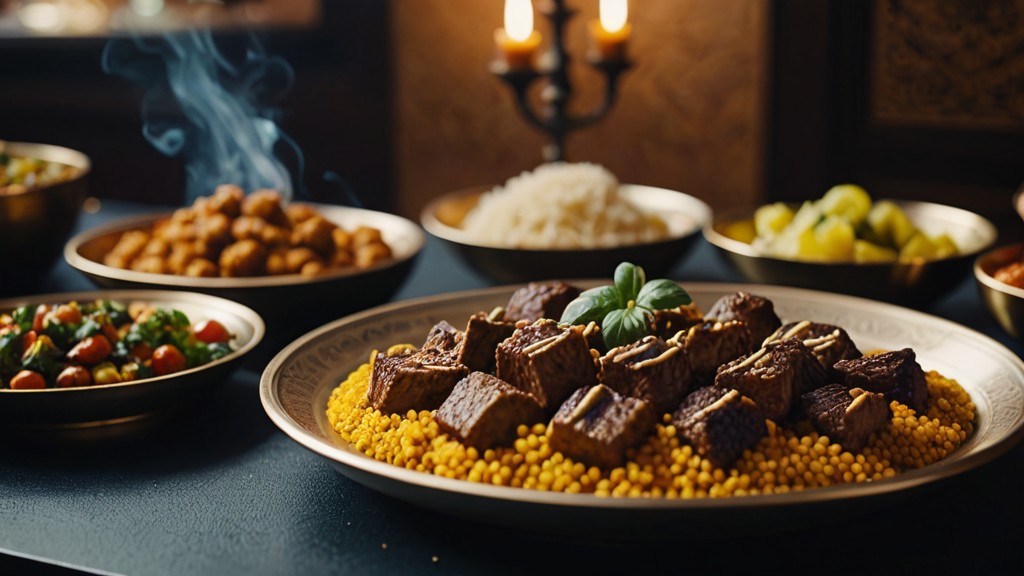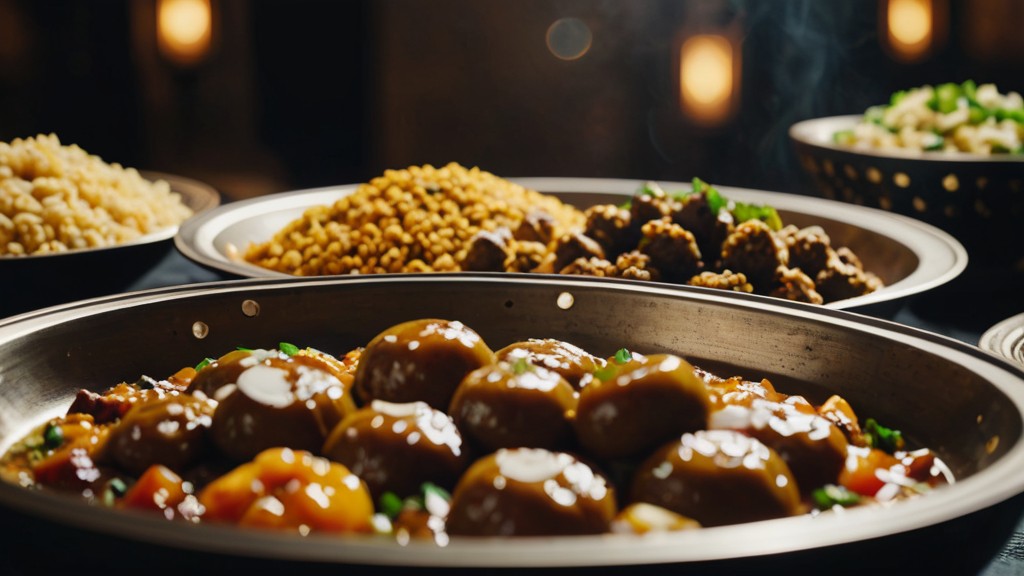Iconic Arabian Cuisine

Iconic Arabian Cuisine
Introduction to Arabian Cuisine
Arabian cuisine is a vibrant tapestry woven from the rich cultural, historical, and geographical threads of the Arabian Peninsula. This culinary tradition is not only about food; it embodies the social and cultural values of the region, showcasing a history that dates back thousands of years. Each dish tells a story, influenced by the various cultures that have traversed the land, including Bedouins, traders, and nomadic tribes. The result is a distinctive cuisine that is both diverse and harmonious, characterized by the use of local ingredients and traditional cooking methods.
In this article, we will embark on a culinary journey through some of the most iconic dishes of Arabian cuisine, exploring their origins, ingredients, and preparation methods. From the hearty Kabsa to the celebratory Mansaf, we will delve into the flavors and aromas that define these dishes, as well as the cultural significance they hold within their respective communities.
The Rich Heritage of Arabian Culinary Traditions
Arabian cuisine is deeply rooted in its heritage, reflecting the pastoral and agricultural lifestyles of its people. Food is often seen as a central component of hospitality, symbolizing generosity and warmth. Many traditional dishes have been passed down through generations, each family adding its unique twist while respecting the original recipes. This lineage not only preserves culinary techniques but also strengthens familial and cultural bonds.
The region's history of trade has also played a pivotal role in shaping its culinary landscape. Spices, fruits, and other ingredients were exchanged along ancient trade routes, such as the Incense Route and the Silk Road, leading to the introduction of new flavors and techniques. Over time, these influences melded with local customs, resulting in a sophisticated and varied culinary repertoire.
Kabsa: The Quintessential Arabian Dish
The Origins and Cultural Significance of Kabsa
Kabsa is often regarded as the national dish of Saudi Arabia and holds a special place in the hearts of many across the Arabian Peninsula. Its origins can be traced back to the Bedouin tribes who lived in harsh desert conditions, requiring meals that were both hearty and simple to prepare. Traditionally, Kabsa was cooked over an open fire, allowing families to gather around and share the meal, reinforcing the bonds of community and family.
Today, Kabsa is not just a staple but a symbol of hospitality; it is often served during festive occasions, family gatherings, and celebrations. Its preparation is considered an art form, where the cooking process itself is a communal activity, bringing people together.
Ingredients that Define Kabsa
The essence of Kabsa lies in its ingredients, which typically include rice, meat (most commonly chicken, lamb, or beef), vegetables, and an array of spices such as saffron, cardamom, and cloves. The spices used are crucial, as they not only enhance the flavor but also create a fragrant aroma that is characteristic of this dish. The rice is often cooked separately before being mixed with the meat and spices, allowing it to absorb the rich flavors.
Step-by-Step Guide to Preparing Kabsa
- Start by marinating the meat with spices, garlic, and onions for at least an hour.
- In a large pot, heat oil and sauté the marinated meat until browned.
- Add chopped tomatoes, carrots, and bell peppers, cooking until soft.
- Stir in the rice, add water or broth, and season with salt and more spices.
- Cover and let it simmer until the rice absorbs all the liquid and is cooked through.
Variations of Kabsa Across the Arab World
Kabsa can vary significantly across different regions, reflecting local tastes and available ingredients. For instance, in Yemen, a version called Mandi incorporates a unique cooking method where the meat is cooked in a tandoor, imparting a distinct smoky flavor. In the United Arab Emirates, Kabsa often includes raisins and almonds, adding a touch of sweetness and texture. Each variation tells a story of its own, showcasing the adaptability of this beloved dish.
Mansaf: The National Dish of Jordan
The Story Behind Mansaf
Mansaf is not only the national dish of Jordan but is also deeply interwoven with the country's identity and cultural practices. Historically, it was a dish prepared for honoring guests, symbolizing generosity and hospitality. The dish has its roots in Bedouin culture, where it was traditionally served during special occasions such as weddings and religious celebrations.
The preparation of Mansaf involves a communal effort, often involving family and friends, reflecting the social nature of dining in Jordan. It is a dish that celebrates unity, where everyone gathers around a large platter to share in the feast.
Key Ingredients and Their Symbolism
The primary components of Mansaf include lamb cooked in a yogurt sauce, served over rice or bulgur, and garnished with almonds and pine nuts. The use of fermented yogurt, known as Jameed, is essential, imparting a tangy flavor that balances the richness of the lamb. This dish symbolizes the importance of hospitality and community, as it is often served on large platters meant for sharing.
Traditional Preparation Methods of Mansaf
To prepare Mansaf, the lamb is first boiled until tender, and then the Jameed is added to create a creamy sauce. The rice or bulgur is cooked separately and then layered on a large serving platter, with the tender lamb arranged on top. The yogurt sauce is generously poured over the dish, and the final touch involves garnishing it with nuts and herbs. This presentation is not just for aesthetics but also enhances the communal experience of sharing a meal.
Celebratory Significance of Mansaf in Jordan
Mansaf takes center stage during celebrations and significant life events in Jordan, such as weddings, religious holidays, and important family gatherings. Its preparation is often accompanied by traditional music and festivities, reinforcing social bonds. In a country where hospitality is a core value, serving Mansaf is a demonstration of goodwill and respect for guests, making it an integral part of Jordanian culture.
Harees: A Comfort Food Staple
The Historical Roots of Harees
Harees is a dish that has stood the test of time, with roots tracing back centuries to the Arabian Peninsula. It is a traditional comfort food made primarily of wheat and meat, often associated with Ramadan and festive occasions. The simplicity of its ingredients belies the depth of flavor it offers, making it a cherished dish among families.
Historically, Harees was a dish consumed by travelers and nomads due to its nutritional value and ability to sustain energy over long journeys. Its preparation method has remained largely unchanged, making it a culinary treasure that reflects the region's enduring traditions.
Core Ingredients and Cooking Techniques Iconic Arabian Cuisine
The essential ingredients of Harees include wheat, meat (usually chicken or lamb), and a pinch of salt. The wheat is soaked overnight and then ground into a coarse paste, which is combined with meat and cooked slowly until it reaches a porridge-like consistency. This slow cooking method is key, as it allows the flavors to meld beautifully, resulting in a dish that is both hearty and comforting. Iconic Arabian Cuisine
Regional Variations of Harees
Across the Arabian Peninsula, Harees has various regional interpretations. In the Gulf states, it is often prepared with spices and served during Ramadan, while in Levantine countries, it might be flavored with cinnamon and nutmeg. Each variation highlights local culinary preferences and showcases the versatility of this beloved dish. Iconic Arabian Cuisine
Harees in Celebrations and Cultural Events
Harees is especially prominent during Ramadan, where it is enjoyed as a nourishing meal to break the fast. It is also served during weddings and other significant events, symbolizing unity and community bonding. The act of preparing Harees is often a communal effort, further enhancing its role in social gatherings.
The Role of Spices in Arabian Cuisine
Common Spices Used in Iconic Dishes
Spices are the backbone of Arabian cuisine, providing depth, aroma, and flavor to dishes. Common spices include cumin, coriander, turmeric, cinnamon, and saffron, each contributing its unique profile. These spices not only enhance the taste but also add nutritional value, promoting health benefits associated with various spices.
The art of spice blending is crucial in creating signature flavors that define regional dishes. For instance, the spice mix known as Baharat is a staple in many Arabian recipes, providing a warm and aromatic base that elevates the overall dining experience.
The Impact of Spices on Flavor and Aroma Iconic Arabian Cuisine
The thoughtful use of spices in Arabian cuisine results in complex flavor profiles that entice the palate. Each spice has its unique characteristics, and their combinations can create a symphony of tastes that range from sweet and savory to spicy and aromatic. The aroma of spices wafting from a pot of simmering Kabsa or Mansaf signifies the communal spirit of Arabian dining, inviting everyone to the table.
Conclusion: The Legacy of Arabian Cuisine
Preserving Culinary Traditions for Future Generations
As we explore the richness of Arabian cuisine, it becomes evident that these dishes are more than just food; they are a reflection of cultural identity, history, and social bonds. Preserving these culinary traditions is essential for maintaining the cultural heritage of the region. Families play a pivotal role in passing down recipes and cooking techniques, ensuring that future generations continue to enjoy and appreciate the flavors of their ancestors.Iconic Arabian Cuisine
Encouraging Exploration of Arabian Dishes Globally
Arabian cuisine offers a unique opportunity for culinary exploration that transcends borders. As global palates become increasingly diverse, the demand for authentic Arabian dishes grows. Food enthusiasts are encouraged to delve into the rich flavors and traditions of Arabian cuisine, whether through cooking at home or dining in authentic restaurants. This exploration fosters cultural exchange and appreciation, enriching the global culinary landscape. Iconic Arabian Cuisine
FAQs Iconic Arabian Cuisine
What is the most famous dish in Arabian cuisine?
Kabsa is often considered the most famous dish in Arabian cuisine, known for its rich flavors and communal serving style.
Are Arabian dishes spicy?
Arabian dishes can vary in spice level. While some dishes use a blend of spices that can be quite flavorful, they are generally not excessively spicy compared to cuisines known for heat.
What role does hospitality play in Arabian dining?
Hospitality is a core value in Arabian culture. Sharing meals, especially traditional dishes like Kabsa and Mansaf, is a way to express generosity and warmth towards guests.
How can I recreate Arabian dishes at home?
To recreate Arabian dishes at home, gather essential ingredients, familiarize yourself with traditional cooking methods, and follow authentic recipes available in cookbooks or reputable food blogs.
Is Arabian cuisine healthy?
Arabian cuisine can be healthy, as it often includes fresh ingredients, lean meats, and a variety of vegetables. Additionally, the use of spices provides health benefits, making it a nutritious choice.
Here are some external links related to iconic Arabian cuisine that you can use:
- BBC Good Food: Middle Eastern Cuisine
- Taste Atlas: Top 100 Arabic Dishes
- Al Jazeera: Food Culture in the Arab World
- The Spruce Eats: Traditional Middle Eastern Dishes
- New York Times Cooking: Middle Eastern Recipes
- Arabian Gourmet: Recipes and Cooking Tips
